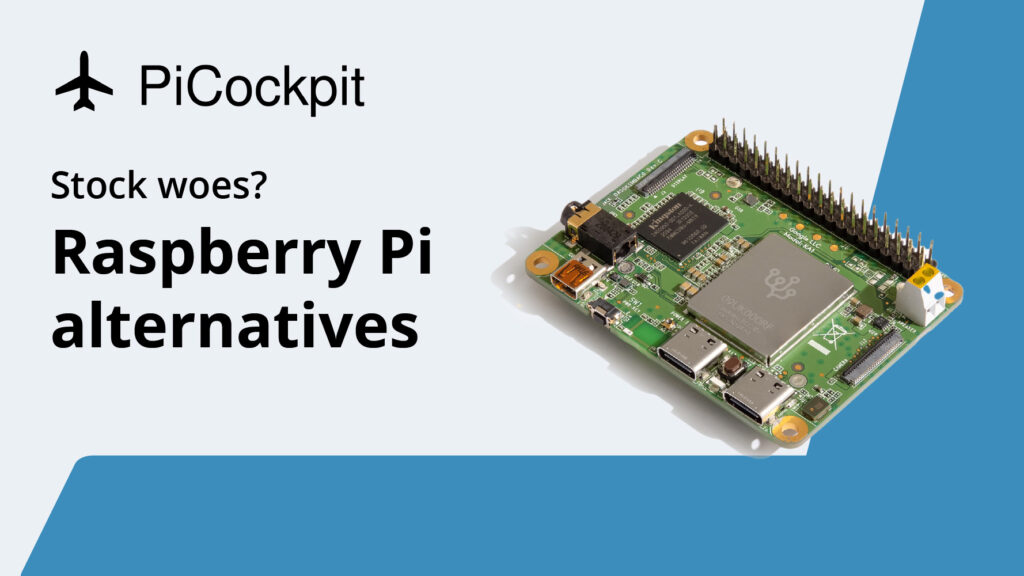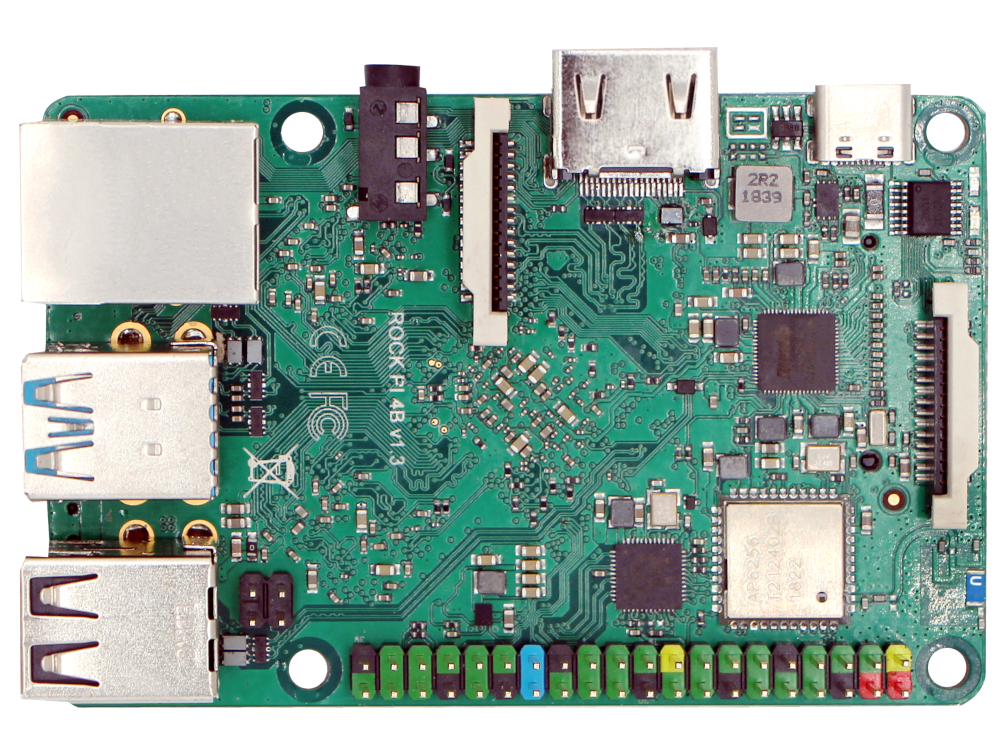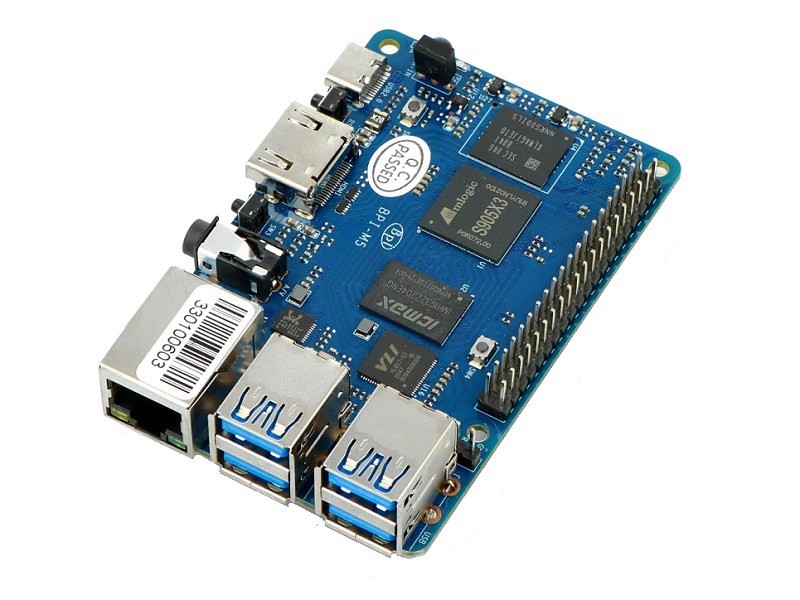Raspberry Pi alternatives in 2022

At some point in your tinkering journey, you might meet up with the limits of the Raspberry Pi.
While the Raspberry Pi’s microcomputers and microcontrollers are very dynamic tools that can help you complete different projects, some other tools are more specialized and are better for specific projects.
In addition, there’s still a shortage out there for boards and that’s a problem for everyone. Specifically, the Pi Zero boards are extremely difficult to get. We’re a Raspberry Pi Approved Reseller so here’s our predictions for stock in the future.
A little caveat about operating system
When you buy a Raspberry Pi, you enjoy the ease of using the Raspberry Pi OS.
Now, when you buy a board that’s not Raspberry Pi, you’re buying a board that would probably work with Android, Ubuntu and perhaps other OSes, but it’s unlikely to work with the Raspberry Pi OS.
The beauty of the Raspberry Pi OS is that it works very well with the Raspberry Pi board. You will avoid a lot of problems related to hardware not working, poor documentation or limited community to seek assistance.
Raspberry Pi 4 general purpose SBC alternative: Rock Pi 4

On the surface, the Rock 4 looks very similar to the Raspberry Pi 4.
Its size and price is about the same — both sell for about $60, are about 85 x 55mm, have 2 x USB 3.0 and USB 2.0 ports, and CSI/DSI ports for both of them.
However, the Rock 4 is a powerful single-board computer (SBC) that has quite a few advantages over the Raspberry Pi 4, including:
- M.2 SSD and eMMC module support (for faster storage than microSD)
- Six-core processor (might be faster for your use case)
Raspberry Pi 4 but with regular HDMI + eMMC: Banana Pi M5

The Banana Pi BPI-M5 is a pretty similarly spec-ed single-board computer compared to the Raspberry Pi 4, but its main advantage over the Raspberry Pi is the pre-soldered eMMC module that can be 16 to 64GB.
eMMC storage is faster and more reliable than microSD, and the Raspberry Pi 4 does not give you the option of having a factory-installed eMMC unlike the Banana Pi BPI-M5.
Furthermore , this board comes with a regular-sized HDMI port. This might be a plus or downside, depending on who you are. As our newsletter survey has shown: only a third of those surveyed prefer a regular HDMI slot. You can sign up for the newsletter at the bottom of this article or on the sidebar on desktop.
Raspberry Pi 4 alternative for AI/ML: Google Coral

While the Raspberry Pi 4 can do some artificial intelligence projects or machine learning projects, it’s generally a bit slow for those purposes.
What you need is one of the Google Coral Dev Boards. Let’s take a look at the Dev Board Mini and the regular-sized Dev Board.
Google Coral Dev Board Mini
The Google Coral Dev Board is a Single Board Computer (SBC) much like the Raspberry Pi. It’s a bit smaller than the Raspberry Pi 4 at 64 x 48mm versus the Raspberry Pi 4’s 86mm x 57mm.
However, unlike the Raspberry Pi, the Coral Dev Board Mini is made specifically for high-speed machine learning.
As you can see from the image above, the Coral Dev Board Mini has a few similarities and differences from the Raspberry Pi including an on-board mono speaker, microphone and power button.
But let’s take a look more in-depth at how the Coral Dev Board Mini compares to the Raspberry Pi 4.
| Coral Mini | Pi 4 | |
| CPU | MediaTek 8167s SoC (Quad-core Arm Cortex-A35) @ 1.3GHz | Quad core Cortex-A72 (ARM v8) 64-bit SoC @ 1.5GHz |
| GPU | IMG PowerVR GE8300 (integrated in SoC) | Broadcom Videocore-VI GPU |
| ML accelerator | Google Edge TPU coprocessor: 4 TOPS (int8); 2 TOPS per watt | Not applicable |
| RAM | 2 GB LPDDR3 | 2/4/8GB |
| Flash memory | 8 GB eMMC, MicroSD | No integrated memory |
| Wireless | Wi-Fi 5 (802.11a/b/g/n/ac); Bluetooth 5.0 | 2.4 GHz and 5.0 GHz IEEE 802.11ac wireless, Bluetooth 5.0, BLE Gigabit Ethernet |
| Audio/video | 3.5mm audio jack; digital PDM microphone; 2.54mm 2-pin speaker terminal; micro HDMI (1.4); 24-pin FFC connector for MIPI-CSI2 camera (4-lane); 24-pin FFC connector for MIPI-DSI display (4-lane) | 2 × micro-HDMI ports (up to 4kp60 supported) 2-lane MIPI DSI display port 2-lane MIPI CSI camera port 4-pole stereo audio and composite video port H.265 (4kp60 decode), H264 (1080p60 decode, 1080p30 encode) OpenGL ES 3.1, Vulkan 1.0 |
| Input/output | 40-pin GPIO header; 2x USB Type-C (USB 2.0) | Raspberry Pi standard 40 pin GPIO header 2 USB 3.0 ports; 2 USB 2.0 ports. |
Google Coral Dev Board

The regular-sized Google Coral Dev Board is about the same size as the Raspberry Pi 4.
The Coral Dev Board is 88 x 60mm while the Raspberry Pi 4 is 86mm x 57mm.
Compared to the Coral Dev Board Mini, the Dev Board is more powerful with faster CPU and memory.
Of course, with more power comes more responsibility. In this case, the Coral Dev Board comes in at $129.99 versus $99.99 for the Mini.
| Coral Dev Board | Pi 4 | |
| CPU | NXP i.MX 8M SoC (quad Cortex-A53, Cortex-M4F) | Quad core Cortex-A72 (ARM v8) 64-bit SoC @ 1.5GHz |
| GPU | Integrated GC7000 Lite Graphics | Broadcom Videocore-VI GPU |
| ML accelerator | Google Edge TPU coprocessor: 4 TOPS (int8); 2 TOPS per watt | Not applicable |
| RAM | 1/4 GB (2GB coming soon) | 2/4/8GB |
| Flash memory | 8 GB eMMC, MicroSD slot | No integrated memory |
| Network | Wi-Fi 2×2 MIMO (802.11b/g/n/ac 2.4/5GHz) and Bluetooth 4.2 Gigabit Ethernet | 2.4 GHz and 5.0 GHz IEEE 802.11ac wireless, Bluetooth 5.0, BLE Gigabit Ethernet |
| Audio/video | 3.5mm audio jack (CTIA compliant); Digital PDM microphone (x2); 2.54mm 4-pin terminal for stereo speakers HDMI 2.0a (full size) 39-pin FFC connector for MIPI-DSI display (4-lane) 24-pin FFC connector for MIPI-CSI2 camera (4-lane) | 2 × micro-HDMI ports (up to 4kp60 supported) 2-lane MIPI DSI display port 2-lane MIPI CSI camera port 4-pole stereo audio and composite video port H.265 (4kp60 decode), H264 (1080p60 decode, 1080p30 encode) OpenGL ES 3.1, Vulkan 1.0 |
| Input/output | 40-pin GPIO header; Type-C OTG; Type-C power; Type-A 3.0 host; Micro-B serial console | Raspberry Pi standard 40 pin GPIO header 2 USB 3.0 ports; 2 USB 2.0 ports. |
How much faster is the Coral vs Pi 4?
An article by Alasdair Allen, from Raspberry Pi, shows some benchmarks that are in favour of the Coral Dev Board.
According to his benchmarks, the Coral Dev Board managed an average inferencing time of 15.7ms while the Raspberry Pi 4 took 82.7ms using Tensorflow Lite. Both tests were done using MobileNet v1 0.75 depth model.
It seems that if you plugged in a Coral USB Accelerator, the Raspberry Pi 4 will become a real ML juggernaut, with inferencing time dropping down to 14.9ms.
Another article by Q-engineering also lays out the outright advantage the Google Coral has over a Raspberry Pi 4:

Raspberry Pi Zero alternatives: Banana Pi BPI-M2 Zero and Orange Pi Zero2
Stock for the Raspberry Pi Zero 2 W is dismal and so people have been looking for various alternatives.
If this is you, then you’d have to decide what your priorities are.

If you need a similar form factor as the Pi Zero, then you could consider the Banana Pi BPI-M2 Zero. This is only if your priorities are strictly about size above all else. For example, if you have a space constraint in your project. We have a deeper comparison between the Zero 2 W and the Banana Pi BPI-M2 Zero here.

However, if size doesn’t matter that much, you could consider the Orange Pi Zero2. The Orange Pi Zero2 is larger than the Pi Zero 2 W, but it’s also more capable. In particular, here are its advantages:
- 1GB RAM (instead of 512MB on the Zero 2)
- USB-C (instead of microUSB)
- Higher CPU speed
Here’s a more in-depth comparison between the two.
Without a doubt, one other board to consider is the Raspberry Pi Pico W. Not only is stock plentiful, but with the new wireless chip, it has become much easier to build simple, connected projects where the Raspberry Pi Zero would be overkill.
Raspberry Pi Pico alternative for microcontroller projects: Arduino

When beginners want to enter the microcontroller scene, they immediately think of the Arduino.
There’s no doubt that the Arduino has carved a place in this market. Even the Raspberry Pi Pico would find it a challenge to shake the Arduino from its reign.
That said, the Raspberry Pi Pico does actually have its advantages over the Arduino.
For one, the Raspberry Pi Pico is one of the cheapest microcontroller boards out there, starting at $4-$7, depending on whether you need headers pre-installed (Pico H), wireless (Pico W) or both (Pico WH, still not released at time of writing).
Arduinos generally cost a lot more. For example, a typical Arduino board that beginners would encounter is the Arduino Uno Rev3, which comes in at $27.60. A board that is similar in size to the Pico, the Arduino Nano, is a bit cheaper at around $21.
Of course, all this hardware is open source so you could buy a third-party one for a lot less.
Here’s a quick table for comparison.
| Raspberry Pi Pico | Arduino Uno Rev3 | |
| CPU Frequency | 133MHz | 16 MHz |
| Microcontroller | RP2040 | ATmega328P |
| Flash memory | 2MB | 32KB |
| RAM | 256KB | 2KB |
| GPIO | 26 (user-usable) | 14 digital, 6 analog |
| Has USB? | microUSB | USB B |
| WiFi and/or BT? | No | WiFi variant available |
| Voltage | 1.8 – 5.5V or 5V USB | 6-20V (7-12V recommended) or via USB. |
| Size | 51x21mm | 68x53mm |
| Languages | MicroPython / C | C |
We’ve written a more in-depth comparison in our Raspberry Pi Pico mega-guide. Click here to see the major differences.
Arduino has more variants than the Raspberry Pi Pico
In the previous section, we compared the classic and most popular Arduino board to the Raspberry Pi Pico.
But the truth is, Arduino has a huge range of boards where some have specific uses.
Frankly, if you have a specific project in mind, you might be better off with one of the special boards from Arduino.
Arduino has three families to choose from: Nano, MKR and Classic. In addition to these, you can also buy kits with everything you need and Shields (e.g. components with a sensor)
Here are the characteristics that distinguish the different categories:
Nano: as the name implies, they are small but with a lot of features. The most basic and inexpensive one is the Nano Every but there are more advanced boards with BLE, ambient sensors (temperature, humidity, pressure), gesture sensors, microphones and more. You can program this series of boards in MicroPython and you can also do Machine Learning with them.
MKR: almost all MKR boards have a radio module that has Wi-Fi, Bluetooth®, LoRa®, Sigfox, NB-IoT. You can buy shields to add environmental sensors, GPS, ethernet, motor control and RGB matrices.
MKR boards use the Cortex-M0 32-bit SAMD21 low power processor and are equipped with a crypto chip for secure communication.
Classic: These are the most basic boards that most hobbyists will start with. They are great for tinkering, testing and learning. The Arduino Uno R3 is in this category.
Arduino Nano RP2040 vs Raspberry Pi Pico WH
In fact, one board that is extremely close to the Raspberry Pi Pico W is the Arduino Nano RP2040 Connect. It uses the same microcontroller, the RP2040, as the Raspberry Pi Pico W and has a wireless module.
The key advantages of the Arduino Nano RP2040 Connect, versus the Pico W, are:
- Bluetooth — although the Pico W has BT hardware, at time of writing, it’s not enabled yet.
- Gyroscope
- Accelerometer
- RGB LED
- Microphone
- Supports Arduino IDE, Arduino Cloud and MicroPython.
In terms of price, the best comparison is with the Pico WH, which comes with headers and wireless, similar to the Arduino Nano RP2040. This means it’s $7 for the Pico WH and about $26 for the Arduino Nano RP2040.
There are many other boards in the Nano family, but if you are looking for a direct competitor to the Raspberry Pi Pico, the Arduino Nano RP2040 Connect is the one to look to.
Raspberry Pi Pico alternative when size matters: RP2040 Stamp

Solder Party has created a RP2040-based microcontroller that’s square and small.
Where the Raspberry Pi Pico is 21mm x 51mm, the RP2040 Stamp is 25mm x 25mm and also has several advantages over the Raspberry Pi Pico including:
- Can be powered by a 3.3V LiPo;
- Has 30 GPIO pins
- Neopixel LED
Basically, this is a Raspberry Pi Pico which is smaller and has more features. However, it also costs about three times the original Pico’s price ($4 vs $10.80), and has no wireless, unlike the Pico W.
Raspberry Pi Pico alternative when size matters: Pimoroni Tiny 2040

Another option beyond the RP2040 Stamp is Pimoroni’s Tiny 2040.
As compared to the Raspberry Pi Pico, the Tiny 2040 is great because it has a USB-C connector, up to 8MB of QSPI flash, a RGB LED and 12 IO pins (with 4 12-bit ADC channels).
Its size is 22.9 x 18.2 mm, compared to the Raspberry Pi Pico’s 21mm x 51mm.
Raspberry Pi Pico’s cheaper alternative: Espressif ESP32 or ESP8266

The Raspberry Pi Pico W has really allowed Raspberry Pi’s microcontroller range to close the gap between the Pico series and the ESP32 and the ESP8266.
The ESP32 does retain one advantage… maybe.
Depending on where you buy your ESP32 from, you might be able to get a microcontroller that rivals the Pico W — at a cheaper price and has a big community behind it.
The chip shortage has hit ESP prices, but Peter Scargill wrote about the prices he paid to get it shipped via Banggood. Peter said he bought a ten-pack of a ESP8266 board called the “Geekcreit® Wireless NodeMcu Lua CH340G V3 Based ESP8266”.
Looking at the product page, they’re quoting $28.99 for 10 and if you buy 40, you get 12% off. Shipping is free to the US.
That means that each board cost $2.90 and this is a board with WiFi. This makes it about half the price of the Raspberry Pi Pico.
At scale, you can save a lot of money by using this series of boards from Espressif. Here’s a comparison between the original Pico and the ESP32.
man – ist das ein durcheinander. unter VEEEGLEICH stelle ich mir doch zumindest ein etabelle vor, in der eineseits die HW zum vergleichen wäre. andererseits kommt das die technik und die SW zum vergleich.
gleich in der ersten tabelle tauchen test ( XOR ) auf, die man nicht miteinander vergleichen kann, weil nur bei 1 einzigen ( !!!!??? ) der tast gemacht wurde – was ist das denn für ein evergleich ?!?!?